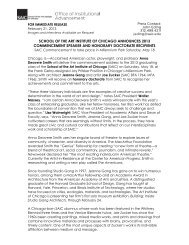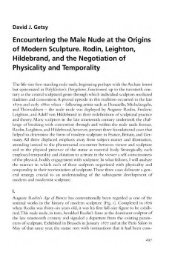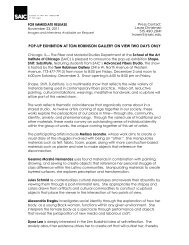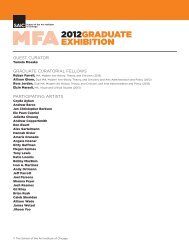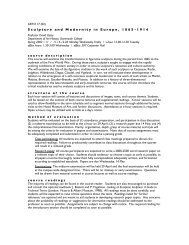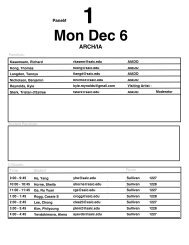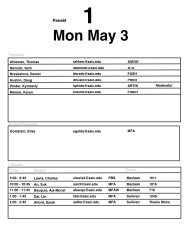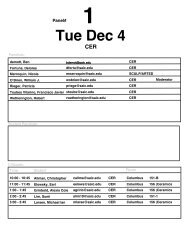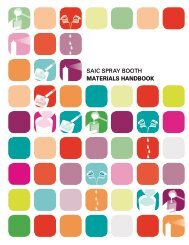i. institutional support and commitment to continuous improvement
i. institutional support and commitment to continuous improvement
i. institutional support and commitment to continuous improvement
You also want an ePaper? Increase the reach of your titles
YUMPU automatically turns print PDFs into web optimized ePapers that Google loves.
School of the Art Institute of Chicago<br />
Department of Architecture, Interior Architecture, <strong>and</strong> Designed Objects<br />
Master of Architecture<br />
Master of Architecture with emphasis in Interior Architecture<br />
In most departments at SAIC, the greater percentage of courses are currently taught by part-time<br />
faculty. In response, the adjunct stabilization reviews were designed <strong>to</strong> assess the faculty <strong>and</strong> curricular<br />
needs of each department. This process, overseen by the Division Chairs <strong>and</strong> the Dean of Faculty,<br />
presents each department chair with the ratio of part-time <strong>to</strong> full-time faculty in their department,<br />
considered in context with the number of courses, enrollments, graduate students, programs <strong>and</strong><br />
special facilities. This analysis has proven valuable in helping departments articulate their needs. For<br />
example, some departments need more full-time faculty, while professional degrees such as the MArch<br />
require a balance of full-time faculty <strong>and</strong> part-time professionals. The adjunct stabilization process has<br />
proven valuable for the Deans Office when planning for future full-time searches.<br />
4) Institutional accreditation self-study<br />
Every ten years, SAIC undergoes a joint accreditation by the School’s two institution-wide accrediting<br />
bodies: the Higher Learning Commission of the North Central Association of Colleges <strong>and</strong> Schools, the<br />
regional accrediting body; <strong>and</strong>, the National Association of Schools of Art <strong>and</strong> Design, the specialized,<br />
discipline-based accrediting body. SAIC’s next accreditation visit will take place in 2012–13 academic<br />
year with the two-year <strong>institutional</strong> self-study process beginning during the 2010-11 academic year.<br />
During Fall 2010, the administration will establish the parameters, workplan, <strong>and</strong> calendar in agreement<br />
with its accrediting organizations. This will inaugurate a two-year period of self-assessment in all areas<br />
of the School, resulting in a major reporting document. Central <strong>to</strong> this assessment will be the strategic<br />
initiatives drafted by the Strategic Planning Committee’s <strong>and</strong> the formation of the committee’s action<br />
groups, which will also be determined this fall.<br />
5) Systemic challenges <strong>and</strong> assessment<br />
The minimum per-course-rate (PCR) for beginning part-time faculty was increased by $200 <strong>to</strong><br />
$3800 for Fall 2010. Faculty with the rank of Adjunct Assistant Professors receive a minimum PCR<br />
of $4000 plus benefits, <strong>and</strong> the small number of Adjunct Assistant Professors with ten or more<br />
years of service who were earning a less competitive wage were moved <strong>to</strong> $4200 PCR. The Part-<br />
Time Concerns Committee, composed of elected faculty working with the Office of the Deans <strong>and</strong><br />
Division Chairs, continue <strong>to</strong> discuss issues of rank <strong>and</strong> compensation, <strong>and</strong> are considering a model<br />
that considers numbers of courses taught rather than years of service. To do so presents a unique<br />
software challenge, <strong>and</strong> staff <strong>and</strong> programmers are currently pursuing this model in PeopleSoft, the<br />
institution’s common data s<strong>to</strong>rage system.<br />
In 2008-09 the faculty in the AIADO department appointed three program direc<strong>to</strong>rs: one for<br />
graduate programs in Architecture <strong>and</strong> Interior Architecture, one for undergraduate programs (BIA<br />
<strong>and</strong> BFA with an architecture pathway), <strong>and</strong> one for Designed Objects. Academic year 2009–10<br />
had five searches, which resulted in eight hires <strong>and</strong> two Full-time Visiting Artist appointments, two<br />
of whom were appointed in the AIADO Department. In, 2010–11, the School is conducting eleven<br />
searches. This increase among full-time searches was due, in part, <strong>to</strong> the thorough data collected<br />
during the adjunct stabilization process, described above.<br />
The financial course sailed by SAIC has remained steady because enrollment numbers have met<br />
projections. For a tuition-driven school such as SAIC—which receives a significant portion of its<br />
annual budget from tuition revenue—this has been advantageous; however, it is not a tenable long-<br />
range plan. As discussed more fully in section I.1.4 Long-Range Planning, one of the major strategic<br />
initiatives going forward is <strong>to</strong> move SAIC <strong>to</strong> a less tuition-driven financial model.<br />
Architecture Program Report | 42



